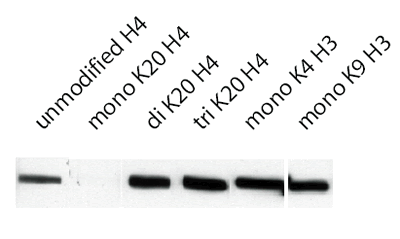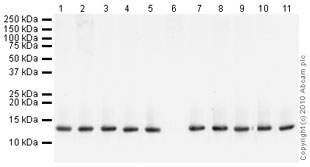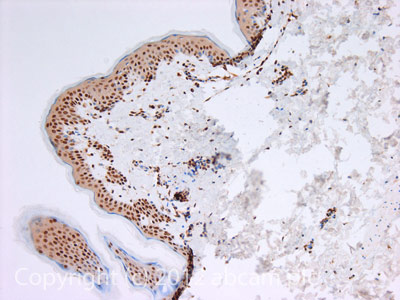Anti-Histone H4 (mono methyl K20) antibody - ChIP Grade
| Name | Anti-Histone H4 (mono methyl K20) antibody - ChIP Grade |
|---|---|
| Supplier | Abcam |
| Catalog | ab9051 |
| Prices | $404.00 |
| Sizes | 100 µg |
| Host | Rabbit |
| Clonality | Polyclonal |
| Isotype | IgG |
| Applications | IHC-P IHC-F WB ICC/IF ICC/IF FC ChIPseq ChIP |
| Species Reactivities | Mouse, Bovine, Human, C. elegans, Drosophila, S. pombe, Mammalian |
| Antigen | Synthetic peptide conjugated to KLH derived from within residues 1 - 100 of Human Histone H4, mono methylated at K20 |
| Description | Rabbit Polyclonal |
| Gene | His4:CG31611 |
| Conjugate | Unconjugated |
| Supplier Page | Shop |
Product images
Product References
The onset of C. elegans dosage compensation is linked to the loss of - The onset of C. elegans dosage compensation is linked to the loss of
Custer LM, Snyder MJ, Flegel K, Csankovszki G. Dev Biol. 2014 Jan 15;385(2):279-90.
NuMA promotes homologous recombination repair by regulating the accumulation of - NuMA promotes homologous recombination repair by regulating the accumulation of
Vidi PA, Liu J, Salles D, Jayaraman S, Dorfman G, Gray M, Abad P, Moghe PV, Irudayaraj JM, Wiesmuller L, Lelievre SA. Nucleic Acids Res. 2014 Jun;42(10):6365-79.
Natural variation of histone modification and its impact on gene expression in - Natural variation of histone modification and its impact on gene expression in
Rintisch C, Heinig M, Bauerfeind A, Schafer S, Mieth C, Patone G, Hummel O, Chen W, Cook S, Cuppen E, Colome-Tatche M, Johannes F, Jansen RC, Neil H, Werner M, Pravenec M, Vingron M, Hubner N. Genome Res. 2014 Jun;24(6):942-53.
DOT1L-mediated H3K79 methylation in chromatin is dispensable for Wnt - DOT1L-mediated H3K79 methylation in chromatin is dispensable for Wnt
Ho LL, Sinha A, Verzi M, Bernt KM, Armstrong SA, Shivdasani RA. Mol Cell Biol. 2013 May;33(9):1735-45.
Genome-wide analysis of LXRalpha activation reveals new transcriptional networks - Genome-wide analysis of LXRalpha activation reveals new transcriptional networks
Feldmann R, Fischer C, Kodelja V, Behrens S, Haas S, Vingron M, Timmermann B, Geikowski A, Sauer S. Nucleic Acids Res. 2013 Apr 1;41(6):3518-31.
Translating dosage compensation to trisomy 21. - Translating dosage compensation to trisomy 21.
Jiang J, Jing Y, Cost GJ, Chiang JC, Kolpa HJ, Cotton AM, Carone DM, Carone BR, Shivak DA, Guschin DY, Pearl JR, Rebar EJ, Byron M, Gregory PD, Brown CJ, Urnov FD, Hall LL, Lawrence JB. Nature. 2013 Aug 15;500(7462):296-300.
A non-canonical role for the C. elegans dosage compensation complex in growth and - A non-canonical role for the C. elegans dosage compensation complex in growth and
Webster CM, Wu L, Douglas D, Soukas AA. Development. 2013 Sep;140(17):3601-12.
Epstein-Barr virus-mediated transformation of B cells induces global chromatin - Epstein-Barr virus-mediated transformation of B cells induces global chromatin
Hernando H, Islam AB, Rodriguez-Ubreva J, Forne I, Ciudad L, Imhof A, Shannon-Lowe C, Ballestar E. Nucleic Acids Res. 2014 Jan;42(1):249-63.
Histone H2A ubiquitination inhibits the enzymatic activity of H3 lysine 36 - Histone H2A ubiquitination inhibits the enzymatic activity of H3 lysine 36
Yuan G, Ma B, Yuan W, Zhang Z, Chen P, Ding X, Feng L, Shen X, Chen S, Li G, Zhu B. J Biol Chem. 2013 Oct 25;288(43):30832-42.
Structural variation-associated expression changes are paralleled by chromatin - Structural variation-associated expression changes are paralleled by chromatin
Gheldof N, Witwicki RM, Migliavacca E, Leleu M, Didelot G, Harewood L, Rougemont J, Reymond A. PLoS One. 2013 Nov 12;8(11):e79973.







